An easy day trip from Andong brings you to the Hahoe Folk Village where Korea’s traditional rural life remains unspoilt. Hahoe is a cute little village full of adorable crooked houses. You wouldn’t be surprised if you met Hansel, Gretel, Rumpelstiltskin, and all the other fairy tale characters in the narrow alleys.
And, of course, a Queen.
In 2019, the time had actually come and none less than Queen Elizabeth II paid a visit to the picturesque village in the south-eastern part of Korea. I assume Elizabeth travelled in a pumpkin carriage, befitting her status. Not being a queen, I took the bus to Hahoe on my day trip from Andong – and what can I say, it was a cheap and comfortable ride, and most importantly, the coach didn’t smell like pumpkin.

It Takes a Village
The Ryu clan of Pungsan founded the settlement in the 15th century during the Joseon Dynasty. It has remained a one-clan community ever since.
The village is laid out according to the geomantic guidelines of Korean Feng Shui in the shape of a lotus flower and is divided into a Namchon, hence, south village, and a Bukchon which translates to north village.

What makes the village so precious is the well-preserved Joseon-era architecture style, where the aristocratic residences have tiled roofs while the commoner’s houses are thatched. Many of the original structures, such as Confucian academies and other institutions and buildings like study pavilions, are also kept alive and active. For this reason, Hahoe has been listed as a World Heritage Site by UNESCO since 2010.
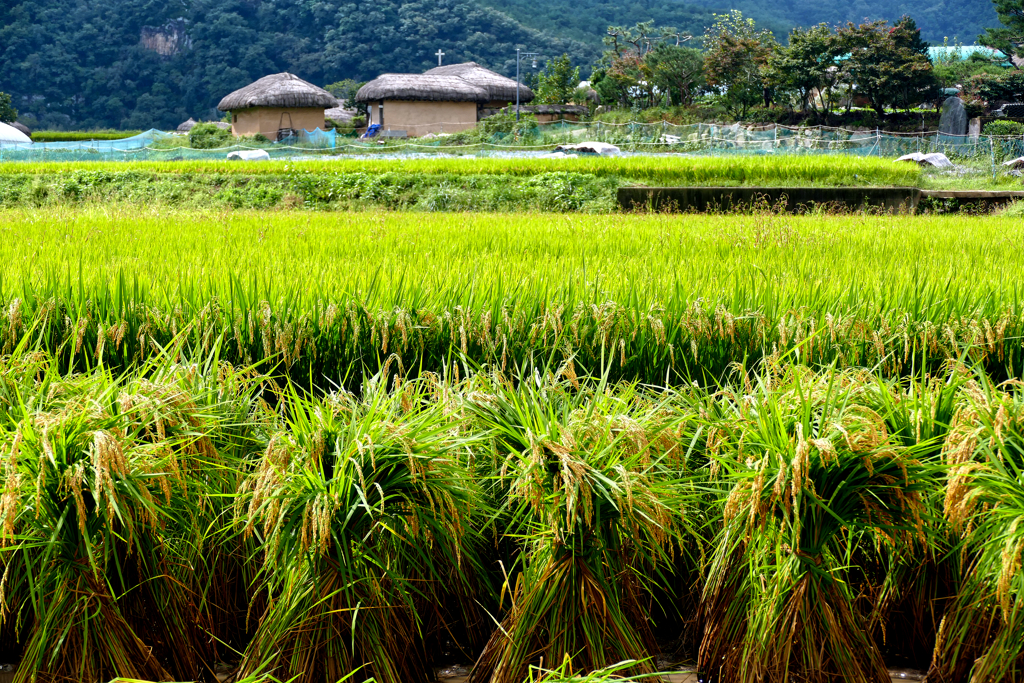
But intangible folk art is also devotedly preserved. First of all, there is the traditional Hahoe masked dance drama, Byeonlsin-gut. Since 2022, it has been on UNESCO’s list of Intangible Cultural Heritage.
Another rite still practiced is the Jeulbul Nori, in which strings of fireworks are fired at the foot of Buyongdae Cliff in honor of the spirits.

Hahoe is the birthplace of renowned Joseon period scholars such as Ryu Un-ryong aka Gyeomam and Ryu Seong-ryong aka Seoae. Internationally, however, Hahoe received the most important accolade when Queen Elizabeth of England visited in April 1999.
Touring Hahoe
Although Hahoe Folk Village is still inhabited by regular people, it can be visited. On average, over 800,000 visitors take advantage of this opportunity every year. I know other UNESCO-listed villages of this sort, such as Shirakawago in Japan, and I have to say that I was pleasantly surprised by Hahoe in that it has still a very genuine and authentic vibe to it. There isn’t such a merciless sell-out where every resident runs a hole-in-the-wall business selling either water or souvenirs. Somehow, wandering around feels a bit like visiting from another planet.
Only on the northern edge of the village near the Mansongjeong pine forest, you’ll find a – completely overpriced – shop that sells handicrafts made from wood and other natural materials. Then there are a couple of small snack bars and that’s basically it.

I’d say you can easily spend two to four hours in Hahoe, depending on how intensively you want to immerse yourself in this fairytale world and whether you also visit the other bank of the river. As you might need some refreshments, I recommend bringing your own beverages and perhaps even a small picnic.

Below, I put together a list of the most iconic homesteads whose premises are open to visitors. You’ll find them listed in an efficient and time-saving order.
Nevertheless, it should be, of course, your top priority to respect the privacy of the residents, not to trespass on private property, not to shout around, and leave no rubbish behind.
Theater for Hahoe Mask Dance Drama
The theater is just a couple of steps south of the shuttle bus stop at the village entrance.
Byeolsingut Talnori is one of the oldest known mask dances in Korea and actually has its origins in Hahoe. The villagers maintain the rite not only as a tourist attraction. The primary aim of the performances in the open-air theater is to honor and appease the village’s guardian spirits.

The dance consists of nine acts. Eleven of the original masks back from the Goryeo Dynasty survived and are housed in the National Museum of South Korea.
The wooden masks embody, among others, a bride and a nobleman, a scholar and his crazy servant, as well as a monk and two lions.
Behind the open-air theater is the Byeongsan Confucian Academy, founded by Confucian scholars. Here you also find a side entrance to the village area.
Hadong Residence
Ryu Gyomok built the Hadong Residence in 1836. He was the descendant of Ryu Seang-ryong and the ninth generation of settlers.

This type of building, called Mindori, has only a few decorations on the rafters. Such traditional upper-class houses usually had a gated area with a tiled roof. However, this gate area has a thatched roof which gives the structure an unpretentious and cozy appearance.
To the right of the entrance are the men’s quarters and to the left a warehouse.
In between there is access to the inner courtyard and the women’s accommodation. Yet, the indoor area for women, called Anchae, and the outdoor area reserved for men, called Sarangchae, are connected.
Anchae and Sarangchae
An Anchae is a part of a traditional Korean home reserved for the women of the household. It can consist of several rooms with different functions. One part is then the so-called Anbang, hence, the most secluded room of the female head of the house.
In smaller houses, the Anchae often only consists of a single Anbang and the kitchen.
Sarangchae and Sarangbang are the rooms for men. They can either be in a separate building or they can be connected to the Anchae or Anbang. However, the male head of the household and his immediate descendants were also allowed to enter the Anbang. In any case, the head couple of the homestead slept in separate rooms.

Male guests in particular were strictly forbidden from entering the Anchae. They were received at the Sarangchae.
For this reason, valuables were kept in the inaccessible Anchae.
These gender-segregated spaces first emerged during the Joseon period and followed the Confucian ideal of strict gender segregation, obviously. Nowadays, however, this is not common anymore.
Jisan Residence
This residence was built in 1841 by Ryu Ji-yeong. He is also known by his pseudonym Jisan. In 1841, he moved out of his parents’ house Yeomhaengdang, and started his own family.

The building consists of a Munganchae, hence, a small lodge at the entrance to the grounds, and a U-shaped main building.
Attached on the left are the men’s and women’s rooms and on the right is a separate quarter. An inner courtyard connects the buildings. The men’s quarters have a wooden veranda overlooking Mount Hwasan. This clearly shows the layout of the village, which is structured from the center outwards.

The historic house also has a beautiful vegetable garden and offers visitors a large parking lot. This is relevant since Jisan is one of the traditional houses where guests can spend the night. For KR₩ 120,000 per night, four to five people can comfortably fit here and feel like the descendants of Hahoe’s founders.
Yeomhaengdang Residence
In 1797, Ryu Chi-mok commissioned Yeomhaengdang. Due to its location in the Namchon district, it is also called the Namchon House.
Ryu Chi-mok is the direct descendant of the famous civilian official Ryu Seong-ryong of the Ryu clan’s 9th generation.

Hard to imagine that Yeomhaengdang was originally constructed in a modest size. However, Chi-mok’s great-grandson Ryu Gi-yeong carried out a large-scale expansion in 1878, transforming the complex into a magnificent noble residence.
It consisted of a main building, a Sadangchae, a log house, hence, the so-called Byeoldangchae, and a pavilion. Sadly, the main building and the pavilion burned down in a fire in 1954. Therefore, today the Byeoldangchae is used as the main living space. The pavilion was also restored, the Anchae and Sarangchae followed in 2011.
Juil Residence
Juil House, also called Yangodang, was built in 1624 by Ryu Man-ha. He moved in with his own family after leaving his childhood home of Chunghyodang.
His son Ryu Hu-jang later expanded the house.
It has men’s quarters on the right side and an inner gate area on the left behind which there is a warehouse and the women’s quarters. Next to the women’s quarters is an ancestral shrine.

Unlike a typical traditional upper-class home, Juil Residence has no main gate areas. This places the entrance between the men’s quarters and the inner gate areas and leads to the women’s quarters. However, in order to prevent the women of the house from being seen by male visitors, there is a privacy wall in front of this part of the house.
The attached Yongmogak Shrine houses Ryu Seong-Ryong’s valuable book collection, including Jingbirok, a book documenting Korea’s Imjin War in the late 16th century.
Yu Siju House
Although the actual date of construction is unknown, the style of the house suggests that it was built in the mid Joseon period. The complex originally consisted of two buildings, but one was lost in a flood in 1934. The remaining building, which served as Anchae or inner part, is surrounded by columns and has a beautiful gable roof.
Particularly noteworthy is a small wall that blocks the view from the outer areas to the inner quarters. This was added after the 1934 flood which destroyed the originally detached Sarangchae.
The current owners have set up a small hole-in-the-wall snack bar in the house. You can then enjoy the refreshments in their beautiful garden in the shade of old trees.
Hwagyeongdang Residence
This house, also known as Bukchon Residence*, was built by an official named Ryu Sa-Chun in 1797, in the 21st year of the reign of King Jeongjo of the Joseon Dynasty. To this day, it is one of Hahoe’s representative noble houses.

It consists of a small men’s quarter with two wing structures on either side. Of course, there is also an inner part for women and quarters for the servants near the gate as well as a shrine.
These parts of the house were added by Ryu’s great-grandson Ryu Do-Seong in 1862.
The residence houses priceless cultural treasures such as the Doseongpaldojido. This map of Korea’s eight provinces is believed to date from the 17th century. Ryu Yi-Jwa received it as a New Year’s gift from the king. It is considered an invaluable historical document as it shows Dokdo Island and Jiandao as part of Korean territory.
Bukchondaek* is still as it was centuries ago, except that it is now open to visitors and overnight guests. An overnight stay starts at $270 per night.
Goddess Samsin Tree
According to Korean shamanism, the goddess Samsin resides in this 650-year-old Zelkova tree. The goddess is in charge of pregnancy, birth, and aftercare.

So if you have any needs or desires in this regard, don’t hesitate to write them down on a piece of paper and hang them next to the tree for Samsin to read!
Yangjin Residence
In the late 14th century, Ryu Jong-hye, the first member of the Pungsan-Ryu clan to settle in this colony, chose this location for his residence.
In the 16th century, Ryu Jung-yeong from the 8th generation built a new house on the same site. This was one of the so-called main houses that were passed down to the male successors of a family line. The next owner was Jung-yeong’s son Ryu Un-ryong.
During the Japanese invasions at the end of the 16th century, the house was significantly damaged by fire. Over the decades, several repairs were made.
This house also offers guest rooms, the costs start at KR₩ 50,000.
Chunghyo Residence
The name Chunghyodang means a house of loyalty and kind piety and comes from the teachings of Ryu Seong-ryong, who promoted said virtues to the king and the parents.
Ryu Seong-ryong was a respected statesman, particularly for his foresight in military strategy and his service as chief state councilor during the Japanese invasions of the late 16th century. He lived a rather modest life and also died in a modest house. After his death, his followers and his grandson Ryu Wonji, a Confucian scholar, helped build the Chunghyo Residence in honor of his virtues.

It is a so-called main house, hence, one of the residences that are passed down from the male successors of a family line.
This house consists of a men’s quarter and a women’s quarter. The servants’ quarters at the front of the house were built by Ryu Sang-jo, the descendant of Ryu Seong-ryong, to house his soldiers after he was appointed military minister.
There is also an ancestral shrine behind the house.
Jakcheon Residence
This is an upper-class house that is believed to have been built in the middle period of the Joseon Dynasty.
There were once two main buildings in this complex, but one was lost in a flood in 1934. Today only the women’s quarters and the warehouses remain. Although this house only consists of one building, the men’s wing is separated from the other rooms by an external wall to prevent the women of the house from being seen by male visitors.
The name is derived from a district in present-day Mungyeong City where Ryu Do-gwan, the ancestor of the current owner, lived before moving to Hahoe.
Pavilions
There are some significant public buildings in the north-eastern part of the village.
The Binyeon Pavilion was built in 1583 by Ryu Unryong aka Gyeomam. He then used it as a study and a library.
South of Binyeon is the Wonji Pavilion, which Ryu Seongryong had built in 1573 when he returned to his home village on the occasion of his father’s death. After his retirement, he spent much of his free time in this pavilion.

Between the two pavilions stands the Queen Elizabeth II Memorial Hall, where photos and relics from the Queen’s visit are exhibited. The monarch visited Hahoe in 1999 and celebrated her 73rd birthday with the villagers. Since the visit, the Queen has been greatly revered in the village, and on the occasion of her passing in 2022, Hahoe was in deep mourning. Back then, more than 8,000 people visited the memorial altar for the late Queen on a single day.
Take Me to the River
On the river bank in the northeastern part of the village, Ryu Unryong had planted the Mansongjeong pine forest. It was a windbreak forest to compensate for the area’s topological weaknesses.
If you walk through the pine forest down to the beach, you can take a wooden ferry across the narrow river to the opposite bank. As you climb to the top of Buyongdae Cliff, you can enjoy breathtakingly beautiful views of the village and the fertile surrounding land.
The Confucian Buyongdae Academy is also located up there, and it is flanked by two pavilions where scholars can study in a serene ambiance.
Hahoe World Mask Museum
The Hahoe World Mask Museum is located at the entrance of the Hahoe Village complex. It is therefore advisable to visit it either before or after going to the village.
More than 250 Korean and foreign masks are displayed here. This way, you can compare the world’s different mask cultures.
A small gift shop sells reproductions of the masks as well as other trinkets and tourism books about Andong and the local culture.

The heart of the museum is the collection of masks and costumes used in Hahoe Byeolsingut Talnori, obviously. Strictly speaking, Byeolsingut Talnori is a combination of mask dance and drama but at the same time, it is also a shamanic ritual. The nine-act plays have been performed since the 12th century. They make fun of the ruling class and also try to defuse tensions between different social classes.
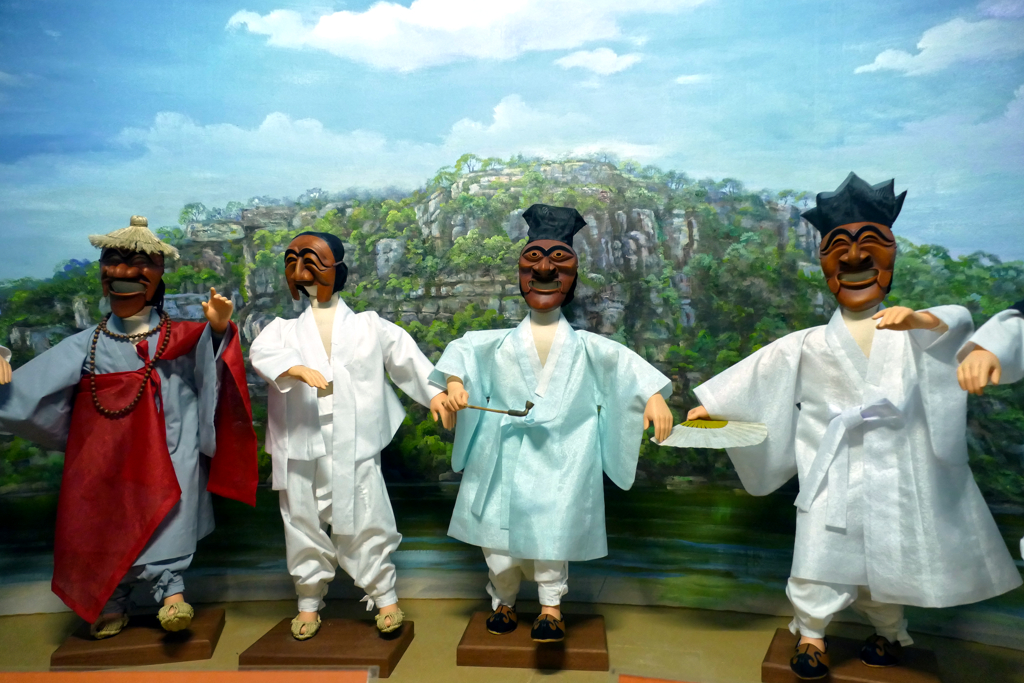
In addition, the shaman rituals serve to ensure a successful year and are intended to prevent natural disasters.
The entrance fee is KR₩ 1,500 but normally, it is included in the total price for the village visit. The museum is open daily from 9.30 a.m. to 6 p.m.
Map
Practical Information
When to Go, How to Get There, And How to Get Around
The Hahoe Folk Village can be visited from March to October from 9 a.m. to 6 p.m. From November to February, they send you home at 5 p.m. – unless you stay overnight, of course.
A visit to Hahoe is worthwhile at any time of the year: In spring, the blooming cherry blossom trees are beautiful, and the rice grows particularly lush and green in summer. In autumn the foliage brings a fantastic spectrum of colors. Winter is cold and harsh, but it has a distinctive atmosphere.
The complete ticket including the village, the shuttle buses, and the museum costs KR₩ 5,000.
The nearest city to Hahoe is Andong. From there, bus #246 will take you to the village’s main parking lot in less than an hour. Then, you can walk or take the shuttle bus to the very village entrance. Remember that in any case, you will be doing quite a bit of walking, mostly on unpaved dirt roads. So wear comfortable shoes like sneakers or even hiking boots. The latter is especially recommended if you want to climb the mountain on the eastern bank.
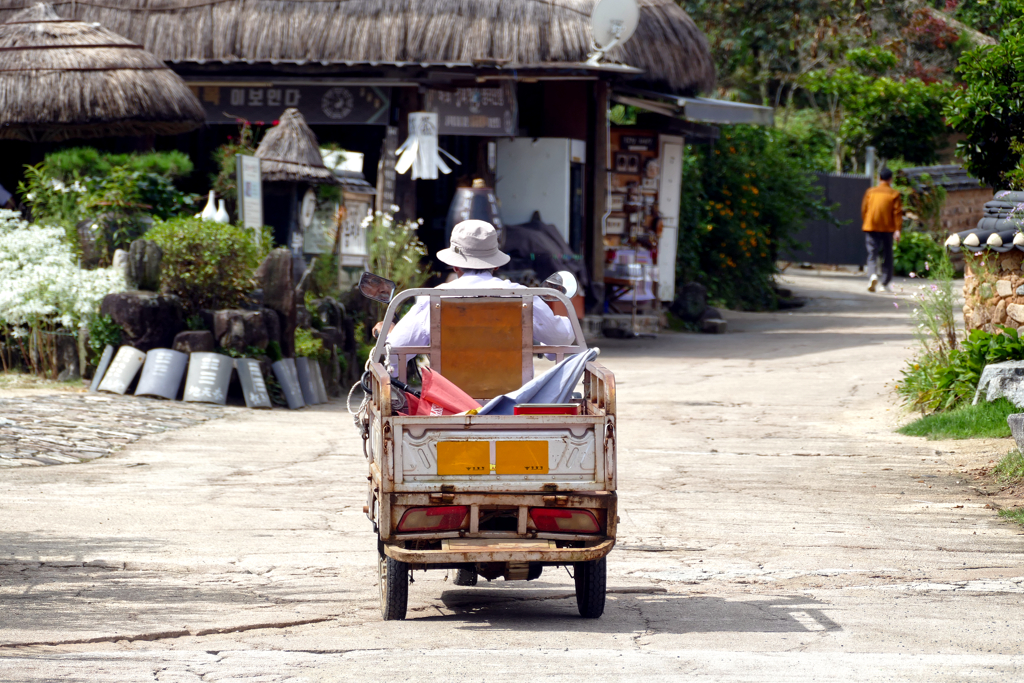
If you prefer to explore the village cycling or driving a golf cart, you can rent both at the village entrance.
If you can arrange it, you should visit Andong and Hahoe during the mask dance festival. It is held every year in September and is a unique cultural happening.
Unless you’re not already in Andong, you can reach the city easily from various places by train or bus. Seoul, for example, is just over two hours away if you take the KTX. To Busan, it is 2.5 hours by train and 3.5 hours by bus, and to Gyeongju 1.5 hours by Intercity Bus.
Where to Stay
There is a range of Hanok stays available in the village, from simple, cozy accommodations with shared bathrooms to luxury ones. An overnight stay in the village is undoubtedly the best way to enjoy Hahoe in its entirety. A Hanok stay is in any case a unique experience. In Hahoe, however, it becomes truly memorable. As soon as the day trippers are gone, you practically have the place to yourself. An early morning stroll or sunset walk will allow you to discover the village at its best.
It’s a good idea to book your Hanok stay in advance.
Normally you pay cash directly to the owner. Starting prices are around KR₩ 50,000 per night per room, not per person; so again a disadvantage for solo travelers.
Yet, if you’d like to check out other suitable lodging options in Andong, you can do so on this map*:
Booking.comWhere to Eat
There are a few small shops scattered throughout the village where you can buy small snacks such as cookies, cup ramen, ice cream, and soft drinks. These are small local shops, not supermarkets.

Surprisingly, there are no real restaurants in Hahoe, either. However, many Hanok accommodations in the village also offer dinner at an additional cost. It’s best to order it right away when booking the room. If this doesn’t work, go to Chogajib Minbak as early as possible to make a dinner reservation. I recommend you take their Andong Jjimdak, a regional chicken dish.
In the village, there are a few overpriced hole-in-the-wall cafes selling coffee, tea, and soft drinks. However, you can find real restaurants behind the mask museum.
Organized Trip
Yes, it’s really easy to get to Hahoe from Andong. However, you might not feel comfortable venturing there by yourself in a country where not only you aren’t able to speak the language, but you even cannot read the letters.
Therefore, you might prefer visiting the Hahoe Folk Village on an organized trip. That’s especially recommended if you’re not coming from Andong but from another place where the connection is not that smooth’n’easy*:
Pinnable Pictures
If you choose to pin this post, please use one of these pictures






Did You Enjoy This Post? Then You Might Like Also These:
How to Experience the Folk Heritage of Korea in ANDONG
The Perfect Itinerary for Three Days in BUSAN
Best And Most Beautiful Bookstores in Seoul
JEONJU – Cradle of Korea’s Cultural Heritage and Home to the Country’s Best Food
Stroll the Fortress Wall of SUWON
INCHEON – Best Things to Do in Korea’s Only Chinatown
GYEONGJU: Two Days in the City Where Korea’s Imperial History Comes Alive
Grand Tour of SOUTH KOREA – A Guide for Individual First-Time Visitors
* This is an affiliate link. If you book through this page, not only do you get the best deal. I also get a small commission to run this blog. Thank you so much for supporting me!

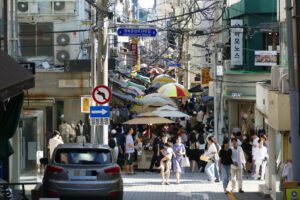



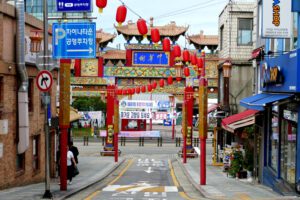


I’ve been following this blog for years and it’s amazing to see how much it has grown and evolved Congratulations on all your success!
Thanks for being such a great support. Yes, the blog is growing…slowly but surely 😉
Thank you so much for your lovely compliment – and for supporting my work 🙂
Give a round of applause in the comments to show your appreciation!
Hahaha, I appreciate your appreciation!
Your positive energy and enthusiasm radiate through your writing It’s obvious that you are truly passionate about what you do
Thank you, Lydia, I’m very happy that my passion for travel shines through 😉
Your blog is a treasure trove of wisdom and positivity. I appreciate how you always seem to know just what your readers need.
Thank you – well, as a passionate traveller, I can anticipate what other globetrotters might need 😉
I am glad you did not need to travel to Hahoe in a pumpkin and found it an easy day trip. I love the masked dancers welcoming people to the town. It would be fascinating to actually see a performance. Good to visit the museum to learn more. It is interesting to see the architecture and I can understand why they are cultural treasures. Good to know we could rent a golf cart to get around.
What a gorgeous village to see! I love the little helper with the hat of wishes, it is so unique (to me at least). The architecture in the village is incredible and is so well maintained after all these years. All of the residences are fascinating to see and to read about. I would want to see the masks in the museums and the cool Hahoe costumes.
It definitely was like a trip into another world – truly unique!